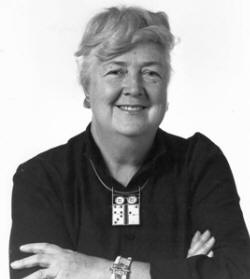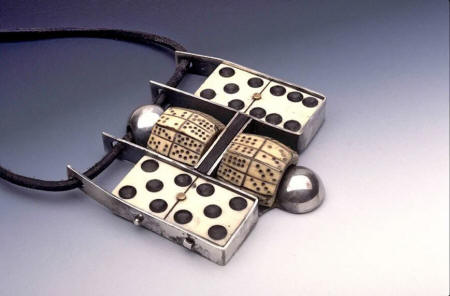

Partner Sarah Spurgeon
Queer Places:
802 C St, Ellensburg, WA 98926
6345 Sand Point Way NE, Seattle, WA 98115
 Ramona Solberg (May
10, 1921 - June 13, 2005)[1] created eccentric yet familiar jewelry using found objects; she was an influential teacher at the University of Washington School of Art and often referred to as the "grandmother of Northwest found-art jewelry".[2][3] She was an art instructor in and around Seattle for three decades as well as a prolific jewelry artist.[4] Solberg eschewed precious materials and made necklaces and pins out of found objects from cultures around the world — bottle tops, dice, sardine cans, dominos, beads, bone. The Sand Point apartment where she lived alone was jammed with boxes and drawers of such items, many of which she collected during her extensive travels. The resulting pieces were large and substantial, meant to be worn rather than displayed in cases.
Sarah Spurgeon passed away in
October 1985, surrounded by loved ones and in the arms of her intimate
friend, jewelry artist Ramona Solberg.
“Solberg was prolific,” said Karen Lorene, who represented Solberg for 20 years at the Facere Jewelry Art Gallery. “If you see a Ramona piece you almost always know it’s a Ramona piece. “She always said, ‘I’m the Henry Ford of jewelry.’ She wanted everyone to be able to afford her work.” While her necklaces could fetch prices north of $6,000, she continued to make a pin called a “fibula” that never sold for more than $125.
Ramona Solberg (May
10, 1921 - June 13, 2005)[1] created eccentric yet familiar jewelry using found objects; she was an influential teacher at the University of Washington School of Art and often referred to as the "grandmother of Northwest found-art jewelry".[2][3] She was an art instructor in and around Seattle for three decades as well as a prolific jewelry artist.[4] Solberg eschewed precious materials and made necklaces and pins out of found objects from cultures around the world — bottle tops, dice, sardine cans, dominos, beads, bone. The Sand Point apartment where she lived alone was jammed with boxes and drawers of such items, many of which she collected during her extensive travels. The resulting pieces were large and substantial, meant to be worn rather than displayed in cases.
Sarah Spurgeon passed away in
October 1985, surrounded by loved ones and in the arms of her intimate
friend, jewelry artist Ramona Solberg.
“Solberg was prolific,” said Karen Lorene, who represented Solberg for 20 years at the Facere Jewelry Art Gallery. “If you see a Ramona piece you almost always know it’s a Ramona piece. “She always said, ‘I’m the Henry Ford of jewelry.’ She wanted everyone to be able to afford her work.” While her necklaces could fetch prices north of $6,000, she continued to make a pin called a “fibula” that never sold for more than $125.
Ramona Lorraine[5] Solberg was born 10 May 1921, in Watertown, South Dakota, but her family relocated to Seattle, Washington before Solberg's second birthday. She enlisted in the Women’s Army Corps in 1943 during the Second World War and served until 1950.[4] Using her G.I. Bill benefits,[5] she went to Mexico where she studied jewelry and textile design at the University of Michoacan in Morelia and textiles at the Belias Artes in San Miguel de Allende.[3][6] She then studied in Oslo, Norway at Statens Kunst og Handverk Skole and worked with jewelry and enameling.[6][5] Upon returning to the United States, she completed both a Bachelor's of Arts and a Master's of Fine Arts degree at the University of Washington[4] and also studied with Ruth Pennington.[3] From 1951 to 1956 Solberg taught at James Monroe Jr. High School, and then worked until 1967 as an associate professor at Central Washington University in Ellensburg, Washington. From that time until her 1983 retirement, Solberg was an art professor at the University of Washington.[4] Solberg is often associated with Pacific Northwest artists and jewelers she taught like Laurie Hall, Ron Ho, Kiff Slemmons, and Nancy Worden.[2]

Though Solberg made some jewelry in her studies, she did not create her first piece of jewelry using beads and found objects until 1956, while at Central Washington State College.[5] Her jewelry was large, rather than typical delicate, precious jewelry. She created her jewelry to be worn and to be worn by large women.[3] In the 1960s, she began traveling. Her first round-the-world trip included visits to Japan, Taiwan, Hong Kong and Nepal, picking up beads at every stop.[5] When she returned, she published a book Inventive Jewelry Making in 1972.[4] Solberg and a Seattle group called Friends of the Crafts began making annual travels through Europe, the Middle East, Southeast Asia, Africa and even one trip to Antarctica to both study crafts in other areas and obtain artifacts that could be used in their own works.[5] Solberg was honored as a Fellow of the Council by the American Craft Council for leadership and ability as an artist and/or teacher.[7] Craft historian Vicki Halper curated a 2001-2002 major traveling exhibition, and wrote a comprehensive, illustrated accompanying publication,[2] after conducting an extensive (35 page transcribed) oral history.[5] Solberg was worked on jewelry right up to her death. She died 13 June 2005 in Seattle, Washington.[4]
My published books: